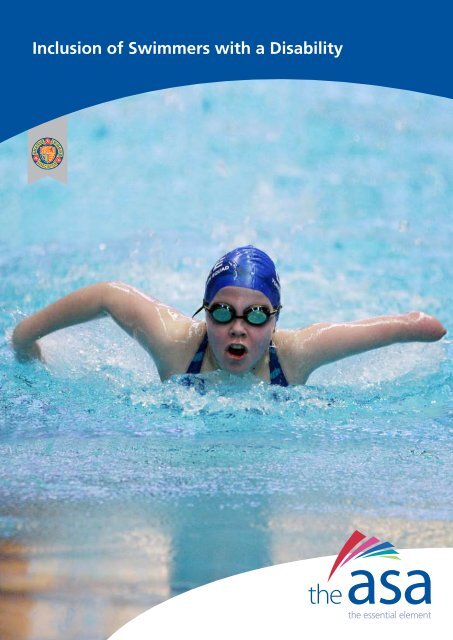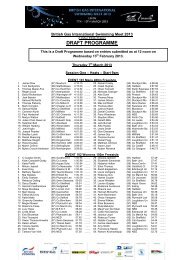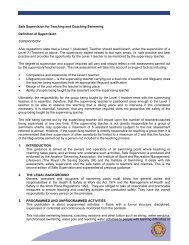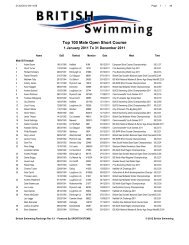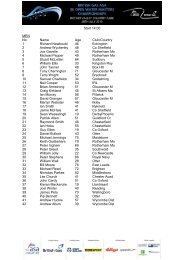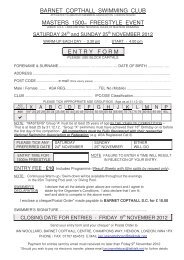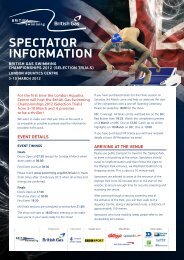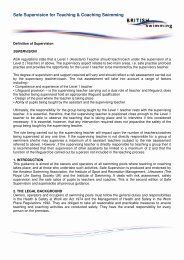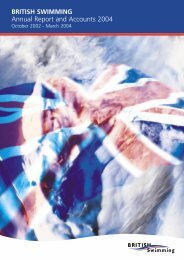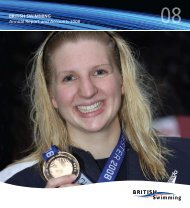Inclusion of Swimmers with a Disability - Swimming.Org
Inclusion of Swimmers with a Disability - Swimming.Org
Inclusion of Swimmers with a Disability - Swimming.Org
You also want an ePaper? Increase the reach of your titles
YUMPU automatically turns print PDFs into web optimized ePapers that Google loves.
<strong>Inclusion</strong> <strong>of</strong> <strong>Swimmers</strong> <strong>with</strong> a <strong>Disability</strong>
Contents<br />
3<br />
3<br />
3<br />
4<br />
5<br />
7<br />
9<br />
11<br />
19<br />
20<br />
21<br />
23<br />
24<br />
25<br />
<strong>Disability</strong> access<br />
Awareness <strong>of</strong> issues relating to<br />
health & safety, assisting and<br />
handling<br />
Teaching and learning<br />
Parents/carers as partners<br />
Overview <strong>of</strong> a variety <strong>of</strong><br />
conditions<br />
<strong>Swimming</strong> stages<br />
Practical considerations<br />
Developing swimming skills<br />
Additional considerations<br />
Supporting and assisting<br />
in the water<br />
Next stage<br />
Classification<br />
Conclusion<br />
Useful websites<br />
Acknowledgements<br />
1<br />
British <strong>Swimming</strong><br />
Carole Barough<br />
Liz Christian<br />
Kaye Savory<br />
Jill Stidever MBE<br />
The ASA Technical <strong>Disability</strong><br />
<strong>Swimming</strong> Committee<br />
Youth Sport Trust<br />
Portage and Leicester Penguins SC
Introduction<br />
This publication contains<br />
information on teaching<br />
swimmers <strong>with</strong> a disability.<br />
It does not aim to cover<br />
every disability but to give<br />
an insight into the main<br />
disabilities that a teacher<br />
might meet in a club/<br />
teaching session.<br />
Throughout the publication, reference<br />
will be made to the fact that teaching<br />
methods are the same for all swimmers.<br />
The ASA has an Equal Opportunities<br />
policy. <strong>Inclusion</strong> <strong>of</strong> swimmers is very<br />
much encouraged in the belief that all<br />
swimmers should have the opportunity<br />
to achieve their full potential.<br />
<strong>Swimmers</strong> <strong>with</strong> a disability have<br />
the same range <strong>of</strong> ability, from<br />
non-swimmers to elite performers.<br />
Their interests range from social to<br />
competitive swimming, together <strong>with</strong><br />
many other water based activities.<br />
There is, therefore, a need for teachers<br />
to become better informed so that all<br />
have access to the best possible<br />
teaching practices.<br />
2
<strong>Disability</strong> Access<br />
The <strong>Disability</strong> Discrimination Act 1995<br />
(DDA 1995) is a UK Parliamentary Act,<br />
which makes it unlawful to discriminate<br />
against people in respect <strong>of</strong> their<br />
disabilities in relation to employment,<br />
the provision <strong>of</strong> goods and services,<br />
education and transport.<br />
l This act has been, and will be, altered<br />
in the future <strong>with</strong> the aim <strong>of</strong> making<br />
services and provisions available to<br />
everyone. Current legislation needs<br />
to be considered when any plans for<br />
inclusion are being made to gain the<br />
best possible provision.<br />
In practice this means that new facilities<br />
should incorporate the ideal. Older<br />
facilities require innovative ways <strong>of</strong><br />
making access easier.<br />
Awareness <strong>of</strong> Issues Relating to<br />
Health & Safety, Assisting and<br />
Handling<br />
Risk assessment is the key to all safety,<br />
assisting and handling activities in the<br />
swimming pool environment relating to<br />
both people and equipment. Assistants<br />
need to be familiar <strong>with</strong> mechanical<br />
lifting aids, so they can use them safely.<br />
All risk assessments and training must<br />
be recorded.<br />
Some Common Sense Principles<br />
l <strong>Swimmers</strong> <strong>with</strong> disabilities <strong>of</strong>ten<br />
need help to participate but avoid<br />
lifting wherever possible.<br />
l Always encourage people <strong>with</strong><br />
disabilities to help themselves and<br />
teach them how to do so.<br />
l Make use <strong>of</strong> swimmers own arm<br />
and leg strength.<br />
l Make use <strong>of</strong> graduated steps,<br />
sliding boards, shower chairs, etc.<br />
l Some swimmers will need assisting<br />
but always think, plan and prepare<br />
before you assist.<br />
l Assist for the shortest possible<br />
distance.<br />
l Be aware <strong>of</strong> rough surfaces which<br />
may cause abrasions.<br />
There may be occasions when manual<br />
handling cannot be avoided. Always<br />
discuss, plan and prepare before you<br />
assist.<br />
Before Assisting and Handling<br />
think about:<br />
l the TASK<br />
l the INDIVIDUAL<br />
l the LOAD<br />
l the ENVIRONMENT.<br />
Extra considerations<br />
l Ensure that any participants <strong>with</strong><br />
balance problems are <strong>of</strong>fered<br />
assistance when walking on a wet<br />
poolside.<br />
l <strong>Swimmers</strong> <strong>with</strong> lower limb impairment<br />
may need assistance/prosthesis<br />
needed near poolside/alternative<br />
assistant (chair, skateboard etc).<br />
l Take care when a participant <strong>with</strong><br />
paraplegia or those <strong>with</strong> minimum<br />
control <strong>of</strong> their lower limbs are<br />
entering the water as abrasions,<br />
that take a long time to heal, may<br />
be caused.<br />
l Park wheelchairs parallel to the pool<br />
and ensure that the brakes are on.<br />
l Be aware <strong>of</strong> swimmers who may have<br />
seizures. 1:1 spotters are required for<br />
epileptics. The ASA has a protocol for<br />
competitive epileptic swimmers.<br />
l Walk on the water side <strong>of</strong> the pool<br />
when assisting someone.<br />
Safety <strong>of</strong> swimmer and helper is <strong>of</strong><br />
paramount importance. Ask for help<br />
or further training if in doubt.<br />
Teaching and Learning<br />
There is an ever-growing involvement<br />
<strong>of</strong> people <strong>with</strong> disabilities in teaching<br />
classes and swimming club provision.<br />
There is still a place for alternative<br />
arrangements either long term or on<br />
a temporary basis. Provision may be:<br />
l fully integrated<br />
l included and supported<br />
l separate provision.<br />
The swimming programme, the time<br />
and the content will have a bearing on<br />
an individual’s choice. This choice may<br />
be associated <strong>with</strong> personal preference,<br />
interests and staffing e.g. beginners,<br />
improvers, recreation, swim for health,<br />
competition and other aquatic<br />
disciplines.<br />
Assessment <strong>of</strong> Need<br />
Determining the specific needs <strong>of</strong> any<br />
participant is an essential pre-requisite<br />
to his/her successful involvement in any<br />
swimming session or club. These may<br />
be determined by:<br />
l direct consultation <strong>with</strong> the individual<br />
and parent or carer<br />
l swimming background<br />
l completion <strong>of</strong> Club registration<br />
forms<br />
l observation <strong>of</strong> the swimmers ability in<br />
the water<br />
l age.<br />
Should the group not be able to provide<br />
for the specific needs, the swimmer<br />
should be given contact information and<br />
directed to another more appropriate<br />
provision. Local knowledge is invaluable<br />
at this time as well as advice from the<br />
Governing Body.<br />
Constant monitoring <strong>of</strong> progress should<br />
take place and achievement <strong>of</strong> goals<br />
should be reviewed on a regular basis.<br />
3
Teachers should be upskilling constantly<br />
in order to ensure that they are abreast<br />
<strong>of</strong> new ideas and initiatives.<br />
<strong>Swimming</strong> fundamentals and<br />
safety skills<br />
All swimming sessions regardless <strong>of</strong><br />
ability should include practices to ensure<br />
the swimmer is pr<strong>of</strong>icient, happy and<br />
safe. Basic Safety Skills should form the<br />
basis <strong>of</strong> any swimming programme.<br />
These skills include:<br />
l entry<br />
l exit<br />
l buoyancy/balance<br />
l rotation/orientation<br />
l aquatic breathing<br />
l travel<br />
l co-ordination<br />
l spatial awareness.<br />
Teachers should be aware <strong>of</strong><br />
hidden conditions that might present<br />
unexpected problems e.g. asthma,<br />
epilepsy, diabetes, cystic fibrosis, etc.<br />
Specific knowledge about the individual<br />
will determine whether there is an<br />
extra need for a watchful parent or<br />
designated spotter.<br />
Teaching principles<br />
Successful teaching is dependent on:<br />
l good technical knowledge<br />
l willingness to be adaptable<br />
l willingness to further knowledge<br />
l sound knowledge <strong>of</strong> fundamentals<br />
l acknowledgement <strong>of</strong> importance <strong>of</strong><br />
basic safety skills<br />
l ability to deliver appropriate sessions/<br />
schedules to meet individual needs<br />
l awareness <strong>of</strong> hidden medical<br />
conditions<br />
l good observational skills to adapt<br />
strokes to individuals abilities.<br />
Parents/carers as partners<br />
Information, that is relevant to<br />
the swimming situation, needs to<br />
be communicated to the teacher/<br />
coach at time <strong>of</strong> registration. Initial<br />
communication pathways set the<br />
standard for future years.<br />
Useful information is suggested in the<br />
National Plan for Teaching <strong>Swimming</strong><br />
Parent Pack although the following<br />
additional information could be useful<br />
to the teacher:<br />
l is the swimmer able to cope in a<br />
group?<br />
l does the swimmer require 1:1<br />
assistance to move in the water?<br />
l does the swimmer require 1:1<br />
assistance to understand instructions?<br />
l does the swimmer have a special<br />
need that is not apparent?<br />
l has the disability been recently<br />
acquired (ie. amputation, paraplegia)<br />
and so is new to the swimmer?<br />
l are there any restrictions or limitations<br />
in or under the water?<br />
l does the swimmer require medication<br />
during session?<br />
Medical information needs to be<br />
shared where the safety <strong>of</strong> the<br />
swimmer or teacher is concerned.<br />
For all swimmers, the greatest skill is<br />
achieving a safe breathing position.<br />
Horizontal Float<br />
Holding Poolside<br />
Vertical Float<br />
4
Overview <strong>of</strong> a variety <strong>of</strong> conditions<br />
A brief outline <strong>of</strong> some <strong>of</strong> the more<br />
common medical conditions likely to be<br />
encountered is listed below, together<br />
<strong>with</strong> some additional observations.<br />
Achondroplasia (Dwarfs)<br />
In the majority <strong>of</strong> cases this a genetic<br />
condition <strong>with</strong> people having restricted<br />
growth.<br />
l Attention may be needed to achieve<br />
balance and initial safe body position.<br />
l Once water confidence and controlled<br />
breathing have been achieved, move<br />
towards a conventional swimming<br />
technique.<br />
Arthritis<br />
Osteoarthritis – this is due to wear and<br />
tear on joints particularly hips and knees.<br />
Rheumatoid – this is a hereditary<br />
condition causing inflammation <strong>of</strong> joints.<br />
Can affect any age group. Also known<br />
as Stills disease in children.<br />
l Sculling is very useful in the early<br />
stages as it causes less pain and<br />
propulsion can be gained using<br />
minimum effort.<br />
l Breathing is easier when supine<br />
(on back).<br />
Arthrogryposis<br />
Due to a congenital condition<br />
from birth. It causes multiple joint<br />
contractures and is characterised by<br />
muscle weakness.<br />
l Weight bearing is possible but<br />
movement is limited by tightness <strong>of</strong><br />
the joints.<br />
Cerebral Palsy<br />
This is due to an oxygen deficiency at<br />
birth or during an accident that may<br />
result in some <strong>of</strong> the difficulties listed<br />
below.<br />
l Reduced muscle power.<br />
l Increased muscle tone, causing stiff<br />
flexed limbs (spastic).<br />
l Difficulty in breath control and<br />
swallowing.<br />
l Involuntary, uncontrolled movements<br />
– uncoordinated (atheoid).<br />
l Disturbance <strong>of</strong> balance (ataxic).<br />
l Possible speech problems.<br />
l Possible cognitive impairment.<br />
There are three types <strong>of</strong> Cerebral Palsy<br />
<strong>with</strong> further descriptions that describe<br />
limbs affected.<br />
Spastic<br />
l Increased muscle tone making limbs<br />
appear stiff.<br />
Athetoid<br />
l Co-ordination is poor because <strong>of</strong> the<br />
involuntary movements and many may<br />
appear clumsy. However symmetrical<br />
movements are easier to learn.<br />
l Breathing difficulties may be apparent.<br />
Ataxic<br />
l The individual may lose balance<br />
<strong>with</strong>out prior warning.<br />
Medical descriptions <strong>of</strong> cerebral palsy<br />
may include:-<br />
Quadraplegic - both legs and arms are<br />
involved. The individual may be in a<br />
wheelchair if severely affected.<br />
Diplegic - legs affected more than arms.<br />
Tend to walk on toes <strong>with</strong> knees turned<br />
or rotated inwards. May/may not use<br />
wheelchair.<br />
Hemiplegic - either left or right side <strong>of</strong><br />
body involved. <strong>Swimmers</strong> who have had<br />
a stroke may be considered in the same<br />
way.<br />
Dysmelia/Amputees<br />
Dysmelia is congenital from birth,<br />
amputee is acquired as a result <strong>of</strong><br />
trauma/accident.<br />
l Affected limbs may require protection<br />
especially if new. Be careful not to<br />
bang them accidentally.<br />
l The swimmer may need to remove a<br />
prosthesis (artificial limb) close to the<br />
poolside.<br />
l Individuals <strong>with</strong> lower limb loss should<br />
establish a safe means <strong>of</strong> moving<br />
around the poolside.<br />
l Individuals may take longer to achieve<br />
balance.<br />
Achrondroplasia<br />
5
Multiple Sclerosis<br />
This is due to damage to the myelin<br />
sheaf. When the myelin is damaged<br />
there is interference <strong>with</strong> messages<br />
between the brain and other parts <strong>of</strong><br />
the body.<br />
l Swimmer’s co-ordination may be<br />
affected.<br />
l <strong>Swimmers</strong> will have good and bad<br />
days.<br />
l Early achievement is essential to aid<br />
longer term mobility.<br />
l <strong>Swimmers</strong> may tire easily.<br />
Muscular Dystrophy<br />
This is congenital from birth condition<br />
although it is not obvious until later. It<br />
is a progressive degenerative disease <strong>of</strong><br />
muscles.<br />
l <strong>Swimming</strong> helps to keep muscles as<br />
fit as possible.<br />
l <strong>Swimmers</strong> have good and bad days.<br />
l Activities should be adapted<br />
accordingly.<br />
l As much as possible should be<br />
taught in the early stages.<br />
Osteo-genesis Imperfecta (Brittle<br />
bones)<br />
This is due to a congenital condition<br />
from birth.<br />
l Bones may break easily.<br />
l Medical limitations may be set.<br />
l Care is needed to avoid contact <strong>with</strong><br />
the poolside and other swimmers.<br />
Spina Bifida and spinal injuries<br />
resulting in paraplegia/tetraplegia<br />
This is due to a lesion or injury to the<br />
spine. The point <strong>of</strong> the lesion/break on<br />
the spine will determine the degree <strong>of</strong><br />
paralysis.<br />
l Many may have total sensory and<br />
motor loss below the site <strong>of</strong> the<br />
lesion.**<br />
l Care must be taken <strong>of</strong> paralysed limbs<br />
so that they do not get trapped or<br />
trail on abrasive surfaces when lifted<br />
or handled.<br />
l The swimmer may not notice wounds<br />
that take a long time to heal.<br />
l The swimmer may be incontinent but<br />
this is no barrier to swimming.**<br />
** Consideration should be given to<br />
discreet changing facilities.<br />
Strokes<br />
This is due to bleeding into the brain<br />
and <strong>of</strong>ten causes a degree <strong>of</strong> paralysis,<br />
usually to one side <strong>of</strong> the body.<br />
l Rehabilitation may bring back some<br />
movement especially when new<br />
balance has been achieved.<br />
l Speech is <strong>of</strong>ten affected,<br />
understanding is not.<br />
l Frustration is displayed <strong>of</strong>ten because<br />
<strong>of</strong> limitations in communication.<br />
Sensory impairments<br />
Visual<br />
This can range from total loss (blind) to<br />
individuals who remove their glasses and<br />
cannot see clearly.<br />
Hearing<br />
This can range from totally deaf to loss<br />
<strong>of</strong> hearing in a crowded environment,<br />
loss <strong>of</strong> pitch and to those who cannot<br />
hear when they remove their aids.<br />
Learning Disabilities<br />
This is due to a congenital condition or<br />
as the result <strong>of</strong> infection, injury, poison<br />
or nutrition.<br />
Other swimmers, who do not fit the<br />
descriptor above, may have learning and<br />
/or co-ordination difficulties that could<br />
affect learning to swim. Some examples<br />
are:- ADHD, Down’s Syndrome, Fragile<br />
X Syndrome, Aspergers, Dyslexia,<br />
Dyspraxia and Autism.<br />
Hidden conditions<br />
Asthma<br />
A condition that affects the airways to<br />
the lungs. The swimmer may require<br />
prescribed medication prior to or during<br />
exercise. If an attack occurs during the<br />
session sit the pupil out and call for<br />
appropriate assistance.<br />
Epilepsy<br />
A tendency to have recurrent<br />
seizures (sometimes called fits). If a<br />
seizure occurs during the swimming<br />
session, recover/rescue the swimmer<br />
appropriately. Each swimmer requires<br />
a knowledgeable spotter on poolside<br />
at all sessions.<br />
Cystic Fibrosis<br />
An inherent condition where mucous is<br />
formed causing respiratory difficulties.<br />
Tissues and bowl may be required on<br />
poolside.<br />
Heart conditions<br />
A condition where the heart is<br />
damaged.<br />
l A medical certificate is advised.<br />
l Do not over tire, most people know<br />
their own limitations.<br />
Diabetes<br />
A condition where the body produces<br />
little or no insulin.<br />
l Some swimmers may require special<br />
dietary requirements before or after<br />
the session as recommended by their<br />
doctor.<br />
Haemophilia<br />
A generic condition where the blood<br />
fails to clot easily.<br />
l More appropriate to swim in the<br />
prone position when learning to<br />
swim in order to prevent knocking<br />
into obstacles.<br />
Further information on these and<br />
other conditions can be found in the<br />
Caf Directory www.cafamily.org.uk<br />
or from local support groups.<br />
For further information on <strong>Disability</strong><br />
Specific Sports <strong>Org</strong>anisations please<br />
refer to page 24.<br />
6
<strong>Swimming</strong> stages<br />
<strong>Swimmers</strong> <strong>with</strong> a disability require<br />
the same opportunities as their peers<br />
to become familiar <strong>with</strong> the water<br />
environment and to progress <strong>with</strong><br />
swimming skills. Extra time, support<br />
and skill adaptations may be needed.<br />
The teaching principles and practises<br />
used are the same for all swimmers<br />
<strong>with</strong> the techniques adapted to suit<br />
the individual. The important factor<br />
is that rarely are two people identical<br />
and the teacher must consider how<br />
the individual’s physique, mobility<br />
and application affects the swimming<br />
technique.<br />
Breathing skills are very important.<br />
People who have difficulties swallowing<br />
may be at risk and require careful<br />
observation<br />
First steps<br />
The first steps are usually the biggest.<br />
Specialist swimming aids are rarely<br />
required - the purpose being to ensure<br />
safety in as positive a swimming position<br />
as possible, taking into consideration<br />
individual preferences.<br />
Listed below is a variety <strong>of</strong> equipment<br />
that has been found to be useful.<br />
Teachers have differing views on<br />
swimming aids, as do individual<br />
swimmers. Aids can be used to obtain<br />
a safer, streamlined position, they are<br />
not for life saving.<br />
Arm bands/arm rings<br />
l Develop early confidence and<br />
independence.<br />
l Buoyancy can be reduced as<br />
confidence grows.<br />
l Lessons become active.<br />
l They are non restrictive.<br />
Buoyancy suits<br />
l All <strong>of</strong> the above, plus they encourage<br />
a more streamline body position.<br />
Head floats (specialist aids in certain<br />
circumstances)<br />
l Help support head above water line,<br />
but some can restrict streamlining.<br />
Rings<br />
l Short term use for swimmers who<br />
learn propulsion in an upright<br />
position.<br />
Floats/woggles (opposite)<br />
l Encourage a horizontal position.<br />
l Allow early kicking skills to develop.<br />
l Allow concentration on specific<br />
actions.<br />
l Can be adapted to suit very small<br />
hands.<br />
Variety <strong>of</strong> balls<br />
l Encourage confidence in water.<br />
l Can give different amounts <strong>of</strong><br />
buoyancy.<br />
Egg flips (opposite)<br />
l Encourage breathing through the<br />
mouth at surface <strong>of</strong> water.<br />
Toys (opposite)<br />
l Encourage water confidence<br />
(watering cans, squirters).<br />
l Can be used for games.<br />
l Pushing, pulling.<br />
l Can be used as objects to chase.<br />
Sinking objects, eg bricks, hoops,<br />
novelties (opposite)<br />
l Encourage submerging and opening<br />
the eyes under water.<br />
l Can be used to develop other skills<br />
e.g. colours, counting.<br />
Head float<br />
Buoyancy suit<br />
Ring/arm bands<br />
7
Float<br />
Woggle<br />
Egg flip<br />
Sinking objects<br />
8
Practical considerations<br />
Many pools have mechanical assistance to enter/exit the water and these are extremely useful. In some cases,<br />
these can remove the independence <strong>of</strong> the swimmer. Whenever possible, swivel and forward entries, <strong>with</strong> or<br />
<strong>with</strong>out support, should be encouraged. Extra steps to lower from wheelchair to poolside may be required to<br />
foster independence.<br />
action<br />
For whom<br />
Condition<br />
Entries<br />
Use <strong>of</strong> hoist<br />
<strong>Swimmers</strong> who require<br />
maximum assistance<br />
Cerebral palsy quadriplegia<br />
Tetraplegia<br />
Severe arthritis<br />
Steps<br />
<strong>Swimmers</strong> <strong>with</strong> lower or one<br />
side <strong>of</strong> body strength<br />
Hemiplegia<br />
Single arm amputees<br />
Learning disabilities<br />
Arthritis<br />
Polio<br />
Legge-Perthes<br />
Swivel entry<br />
<strong>with</strong> or <strong>with</strong>out<br />
support<br />
<strong>Swimmers</strong> <strong>with</strong> good<br />
upper body strength i.e.<br />
paraplegia<br />
Paraplegia<br />
Cerebral palsy diplegia<br />
Learning disabilities<br />
Polio<br />
Legge-Perthes<br />
Forward entry<br />
from poolside<br />
<strong>with</strong>/<strong>with</strong>out<br />
support<br />
<strong>Swimmers</strong> <strong>with</strong> sitting<br />
balance<br />
Paraplegia<br />
Cerebral palsy<br />
Non weight bearing swimmers<br />
Legge-Perthes<br />
Diving<br />
<strong>Swimmers</strong> <strong>with</strong> good control<br />
sitting on blocks<br />
Lower limb amputees/dysmelia<br />
Diving<br />
<strong>Swimmers</strong> <strong>with</strong> ability to<br />
stand on blocks <strong>with</strong>/<br />
<strong>with</strong>out support<br />
Amputees<br />
Cerebral Palsy<br />
Learning disabilities<br />
Visually impaired<br />
Hearing impaired<br />
9
Advantages Disadvantages Help<br />
Secure<br />
Less pain<br />
Not always available<br />
Slow, suspended entry<br />
Banana board may be required to assist<br />
swimmer to slide from wheelchair to hoist<br />
Usual method <strong>of</strong> entry available<br />
in most pools<br />
Slippery<br />
Steep<br />
Small footholds<br />
Assistant can steady/support by working<br />
from behind swimmer <strong>with</strong> hands holding<br />
rails under swimmer’s arms for safety<br />
Independence<br />
Common method <strong>of</strong> entry<br />
Rough poolsides cause abrasions<br />
Using hands to support at waist level,<br />
assistant can steady entrance to water<br />
Maximum or minimum support<br />
can be given<br />
Leads to more independence<br />
Rough poolsides cause abrasions<br />
Hands on assistant’s shoulders and<br />
support at waist level initially. Can reduce<br />
to hand on elbow, then hand on hand<br />
and eventually independence<br />
From sitting on poolside or sitting<br />
on blocks<br />
Care over water depth<br />
Check allowed to dive (VI,<br />
Down’s syndrome)<br />
Rough surfaces on some blocks<br />
Covering blocks <strong>with</strong> chamois<br />
Fastest entry for competition<br />
Some swimmers may find blocks<br />
awkward to get on to<br />
Some swimmers may require assistance <strong>of</strong><br />
support at hip level to control balance<br />
10
Developing <strong>Swimming</strong> Skills<br />
The basic principles <strong>of</strong> swimming are the same for all swimmers. No two swimmers have the same physique, strength,<br />
balance, physical or learning ability. Be prepared to experiment to find out what works best for an individual. Allow<br />
plenty <strong>of</strong> time for skills to be achieved, practised and developed to maximum ability.<br />
Every swimmer has a unique style regardless <strong>of</strong> ability. The strokes taught should be as near as possible to the norm.<br />
The following are examples <strong>of</strong> possible variations that may assist in the initial stages.<br />
Difficulty Observation Suggestion<br />
body position<br />
Rolls to left or<br />
right<br />
<strong>Swimmers</strong> <strong>with</strong> one side<br />
<strong>of</strong> body stronger than<br />
other<br />
Experiment <strong>with</strong> one or two <strong>of</strong><br />
the following:- Turn head away<br />
from roll on back<br />
Arm action slightly under body<br />
Wider arm entry<br />
On front look to direction <strong>of</strong> roll<br />
Breathe to weaker side initially<br />
Upright<br />
<strong>Swimmers</strong> who are<br />
top heavy until learned<br />
rotational and safe<br />
breathing skills<br />
Teach rotational skills<br />
Balance and aquatic breathing<br />
Hips high, legs<br />
drag low<br />
<strong>Swimmers</strong> where hips<br />
are almost above water<br />
line and unable to move<br />
legs<br />
Raise or lower head depending<br />
on stroke being performed on<br />
back or front<br />
legs<br />
No propulsion<br />
<strong>Swimmers</strong> unable to<br />
alter leg position or<br />
use them<br />
Exaggerate lower head<br />
position to achieve<br />
streamlining<br />
11
Condition Positives Negatives<br />
Over compensation will cause excessive roll<br />
Cerebral Palsy Hemiplegia<br />
Stroke<br />
Amputees<br />
Legge-Perthes<br />
Streamlining<br />
Over compensation will cause<br />
excessive roll<br />
Achondroplasia<br />
Down’s Syndrome<br />
Hydrocephalus<br />
Double leg amputees<br />
Young children<br />
Comfortable<br />
Easy propulsion<br />
Help towards safe conventional<br />
swimming position<br />
Fear may be introduced by over emphasis<br />
<strong>of</strong> early conventional swimming position<br />
Paraplegia<br />
Spina bifida<br />
Streamline<br />
Less resistance<br />
Seeing direction and obstacles<br />
More effort required for breathing<br />
(possibly better to breathe every second<br />
stroke in breaststroke)<br />
Paraplegia<br />
Spina bifida<br />
Double above knee amputees<br />
Streamline<br />
Less resistance<br />
12
Difficulty Observation Suggestion<br />
No leg<br />
propulsion but<br />
<strong>with</strong> minimum<br />
control <strong>of</strong> trunk<br />
and legs to hold<br />
in one position<br />
Co-ordination difficulties<br />
No lower body movement/<br />
control or unable to<br />
perform legal leg kick<br />
Use any leg movement for<br />
balance (leg drills should be<br />
attempted) or drag for less<br />
resistance<br />
Propulsion from<br />
one leg only<br />
Swimmer able to use one<br />
leg for propulsion through<br />
loss <strong>of</strong> limb, disability or<br />
hip restriction<br />
Figure <strong>of</strong> eight or cross centre<br />
line kick<br />
One leg held still, other leg<br />
used<br />
Propulsion or<br />
balance obtained<br />
from one/two<br />
shorter limbs<br />
Swimmer <strong>of</strong> restricted<br />
growth or loss <strong>of</strong> lower<br />
limbs<br />
Use <strong>of</strong> usual leg kick and drills<br />
including (adapted) fins<br />
May be used for balance only<br />
when unable to kick<br />
ARMS<br />
Single arm<br />
propulsion<br />
Upper limb loss<br />
One arm restricted when<br />
attempting work <strong>with</strong> both<br />
arms especially noticeable<br />
in butterfly<br />
Teach as if limb was there<br />
Find position for other arm<br />
that causes less resistance<br />
Use drills for both arms<br />
independently<br />
No arm<br />
propulsion<br />
on front<br />
Upper limbs missing or<br />
very severely restricted<br />
Use water (float initially) as a<br />
pillow, head to side<br />
Develop strong kick and<br />
aquatic breathing<br />
Wide arm<br />
entry<br />
Arms entering water<br />
outside shoulder line<br />
Balance restricted<br />
Used to gain propulsion<br />
through control <strong>of</strong> roll<br />
Analyse use as may be<br />
improving balance, correct<br />
as appropriate<br />
13
Condition Positives Negatives<br />
Cerebral palsy diplegia<br />
Streamline<br />
Less resistance<br />
Improving muscle tone and core<br />
stability<br />
More work for arms<br />
Single leg amputee<br />
Dysmelia<br />
Cerebral palsy hemiplegia (especially<br />
in butterfly)<br />
Arthritis<br />
Stronger propulsion<br />
Aids balance<br />
Legal stroke<br />
Strain at hip level<br />
Illegal in butterfly competition if legs cross<br />
(flutter kick)<br />
Double/single below knee amputees<br />
Achondroplasia<br />
Dysmelia<br />
Aids balance<br />
Single arm amputee<br />
Dysmelia,<br />
Hemiplegia<br />
Stroke<br />
Keeps propulsion, legalises stroke<br />
May cause excessive roll<br />
Dysmelia<br />
Double arm amputee<br />
Cerebral palsy quadriplegia<br />
<strong>Swimming</strong><br />
Difficulties judging direction<br />
Leg amputees<br />
Cerebral palsy diplegia<br />
More effective balance<br />
Shorter pull if not accompanied by roll<br />
14
Difficulty Observation Suggestion<br />
Arms crossing<br />
centre line<br />
under body in<br />
front crawl<br />
Excessive snaking <strong>of</strong> body<br />
Discourage pull across centre<br />
line <strong>of</strong> body<br />
Narrow arm<br />
entry<br />
Arms entering water at<br />
almost same point<br />
Analyse use as may be<br />
improving balance, correct<br />
as appropriate<br />
Breaststroke<br />
arms <strong>with</strong> leg drag<br />
Swimmer <strong>with</strong> leg drag<br />
Use continuous stroke when<br />
there is no leg kick to keep<br />
stroke moving<br />
Scull in<br />
backstroke<br />
Swimmer <strong>with</strong> leg drag<br />
Use initially to keep afloat<br />
where no leg movement -<br />
loose as soon as possible to<br />
keep continuous stroke<br />
Double arm<br />
backstroke<br />
Swimmer <strong>with</strong> balance<br />
and co-ordination<br />
difficulties<br />
Head <strong>of</strong>ten extended<br />
under water to maximise<br />
streamlining<br />
Use to gain maximum<br />
propulsion from arms when leg<br />
kick is weak or unpredictable<br />
Breathing<br />
Swallowing<br />
and blowing<br />
Coping <strong>with</strong><br />
stiffness and<br />
pain<br />
Choking, spluttering,<br />
coughing<br />
Teach on back<br />
15
Condition Positives Negatives<br />
Cerebral palsy hemiplegia<br />
Strokes<br />
Streamline<br />
Less snaking<br />
Swimmer <strong>with</strong> limited core<br />
stability<br />
Paraplegia<br />
Cerebral palsy diplegia<br />
Quadriplegia<br />
Dysmelia<br />
Continual forward movement<br />
Requires considerable effort and breath<br />
timing<br />
Paraplegia<br />
Cerebral palsy diplegia<br />
Quadriplegia<br />
More effective stroke<br />
Restricts stroke once established<br />
Can become habit<br />
Cerebral palsy quadriplegia<br />
Ataxic cerebral palsy<br />
Timing breathing crucial<br />
Athetoid cerebral palsy<br />
Arthritics<br />
Easier position to breathe<br />
Less pain<br />
Unable to see what is going on around<br />
Effort to regain standing position<br />
16
Difficulty Observation Suggestion<br />
Timing<br />
Controlling stroke<br />
as a whole<br />
Movements and breathing out<br />
<strong>of</strong> synchronisation<br />
Balance <strong>of</strong>ten dictates most effective<br />
combination<br />
Work on whole - part - whole <strong>of</strong> stroke<br />
Make stroke as efficient as possible<br />
Action For Whom Condition<br />
Exits<br />
Use <strong>of</strong> hoist<br />
<strong>Swimmers</strong> who require<br />
maximum assistance<br />
Cerebral palsy quadriplegia<br />
Tetraplegia<br />
Severe arthritis<br />
Steps<br />
<strong>Swimmers</strong> <strong>with</strong> lower or one<br />
side <strong>of</strong> body strength<br />
Hemiplegia<br />
Single arm amputees<br />
Learning disabilities<br />
Arthritis<br />
Push up to pool<br />
side<br />
<strong>Swimmers</strong> <strong>with</strong> good upper<br />
body strength i.e. paraplegia<br />
Paraplegia<br />
Cerebral palsy diplegia<br />
Leg amputees<br />
Learning disabilities<br />
Use <strong>of</strong> poolside<br />
corner to push up<br />
<strong>Swimmers</strong> <strong>with</strong> good upper<br />
body strength i.e. paraplegia<br />
Paraplegia<br />
Cerebral palsy diplegia<br />
Leg amputees<br />
Learning disabilities<br />
17
Condition<br />
Positives<br />
NEGATIVES<br />
All abilities and conditions.<br />
<strong>Swimming</strong> to maximum ability.<br />
None<br />
Advantages Disadvantages HELP<br />
Secure<br />
Less pain<br />
Not always available<br />
Slow when cold<br />
Helpers required in pool and on<br />
poolside<br />
Usual method <strong>of</strong> exit available<br />
in most pools<br />
Slippery<br />
Steep<br />
Small footholds<br />
Assistant able to support from behind<br />
swimmer to hold through to hand rails.<br />
Helper to be available on poolside<br />
Independence<br />
Common method <strong>of</strong> entry<br />
Rough poolsides<br />
Use mat/towel to cover poolside<br />
Help from behind at waist level<br />
Independence<br />
Differing heights <strong>of</strong> poolside at<br />
corners<br />
Use mat/towel to cover poolside<br />
18
Additional Considerations<br />
Visual Impairments<br />
l <strong>Swimmers</strong> may need to be guided<br />
around the facility to orientate<br />
themselves.<br />
l Use manual demonstrations in full<br />
view <strong>of</strong> all, together <strong>with</strong> clear<br />
auditory instructions.<br />
l Wear contrasting clothes to the<br />
environment to assist visually impaired<br />
swimmers to follow demonstrations.<br />
l Use music, originating from same<br />
place, to help orientation.<br />
l Use a tapper to notify the swimmer<br />
when nearing the end <strong>of</strong> pool.<br />
l <strong>Swimmers</strong> who wear glasses may<br />
have severe difficulties once they<br />
remove them. Prescription goggles<br />
are available.<br />
Hearing Impairments<br />
l Use clear and accurate demonstrations.<br />
l Use <strong>of</strong> photos or pictures may help.<br />
l Make sure the swimmer can see your<br />
face for lip reading you may need to<br />
move into a lower position on pool<br />
side.<br />
l Some deaf swimmers can pick up<br />
rhythm (eg. <strong>of</strong> a drum) to help <strong>with</strong><br />
timing.<br />
l <strong>Swimmers</strong> who use hearing aids<br />
become more impaired when they<br />
remove them for swimming.<br />
Learning Disabilities<br />
All can be helped by:<br />
l Breaking skills down into small parts.<br />
l Using continual repetition in a variety<br />
<strong>of</strong> ways to achieve the same ends.<br />
l Changing activities <strong>of</strong>ten.<br />
l Using movement exploration and<br />
games approach.<br />
l Ensuring high standards <strong>of</strong> personal<br />
discipline.<br />
l Using accurate demonstration,<br />
pictures and basic signing to reinforce<br />
verbal instructions.<br />
l Allowing time for steps to be learned<br />
and repeating <strong>of</strong>ten.<br />
l Using praise to reinforce small steps -<br />
verbal, thumbs up and smiles work<br />
well.<br />
Medical advice should be obtained<br />
before teaching diving or butterfly<br />
to swimmers <strong>with</strong> Down’s Syndrome<br />
or visual impairment.<br />
19
Supporting and Assisting in the Water<br />
Cradle support<br />
Appropriate for younger child.<br />
Secure, safe, outward facing position.<br />
Easy transition into long arm supported<br />
position on back.<br />
Long arm support on back<br />
Head can be on shoulder or more<br />
advanced at arms length. Helper’s hands<br />
should be palms upward <strong>with</strong> straight<br />
arms.<br />
Physical support may be required in the<br />
water to enable some swimmers <strong>with</strong><br />
a disability make the maximum use <strong>of</strong><br />
their abilities. Not every swimmer<br />
requires 1:1 supported assistance.<br />
Suitable flotation aids may be more<br />
appropriate. Extra assistance must be<br />
given in full view <strong>of</strong> all and <strong>with</strong> the<br />
consent <strong>of</strong> the swimmer.<br />
Support for head in prone<br />
In initial stages float can be used,<br />
progressing to hand support, then no<br />
extra help.<br />
Long arm in prone<br />
Palm support initially at waist level<br />
reducing to minimal support as<br />
confidence is gained.<br />
Support to roll from front to back<br />
Assistant supports swimmer <strong>with</strong> hands<br />
either side at hip level. The adjacent<br />
hand pushes gently whilst the other<br />
hand pulls to perform the rotation.<br />
20
Next Stage<br />
Once able to swim, a variety <strong>of</strong><br />
aquatic opportunities are opened<br />
up for swimmers to pursue in a pool<br />
environment or open water <strong>with</strong><br />
swimming, sailing, canoeing, water<br />
skiing and scuba diving. For many,<br />
lifetime recreational swimming may be<br />
the plan, for others the goal maybe to<br />
follow the competitive route.<br />
The natural progression from learning to<br />
swim for many people is to move into a<br />
training club environment. All training<br />
needs for swimmers are similar and are<br />
covered <strong>with</strong>in coach education. To<br />
ensure a swimmer <strong>with</strong> a disability is<br />
training at the appropriate level,<br />
<strong>with</strong> some modifications, many can<br />
be included in mainstream clubs.<br />
When planning, the coach needs to be<br />
aware <strong>of</strong> extra considerations that are<br />
specific to disability swimming. Two <strong>of</strong><br />
which are the competition calendar and<br />
classification.<br />
Competition Calendar<br />
The dates <strong>of</strong> the major International<br />
meets vary and so the home <strong>Disability</strong><br />
<strong>Swimming</strong> programme needs to plan<br />
around these dates to <strong>of</strong>fer a variety<br />
<strong>of</strong> events at all levels. These may be<br />
included <strong>with</strong>in the Governing Body<br />
structure or run by national or local<br />
groups.<br />
Early competition<br />
Often these are run using either Time<br />
Banding or Time Handicapping systems.<br />
Time Banding<br />
The swimmers are grouped together<br />
according to the time taken to swim<br />
a given distance.<br />
Time Handicapping<br />
The swimmers are handicapped<br />
according to the time taken to swim<br />
a given distance. The slower swimmer<br />
will start first. If the submitted times are<br />
accurate the swimmers should finish<br />
together, producing some very close<br />
races.<br />
21
Classification<br />
Classification, where the aim is to<br />
“ensure a fair playing field for all<br />
swimmers”, is a requirement <strong>of</strong> many<br />
competitions. There are two main<br />
forms <strong>of</strong> classification:<br />
Minimum eligibility criteria for Functional<br />
classification system (S1-S15)<br />
The groups S(SB)(SM) 1-10 are for those<br />
swimmers <strong>with</strong> a functional, visual,<br />
learning or hearing impairment.<br />
S(SB,SM) 11-13<br />
Visually impaired swimmers<br />
The degree <strong>of</strong> vision is measured (<strong>with</strong><br />
the best correction) ranging from blind<br />
to visually impaired.<br />
Functional system<br />
This system means that amputees,<br />
people <strong>with</strong> paraplegia, cerebral palsy<br />
and other physical disabilities can<br />
compete together. It is a swimmer’s<br />
functional ability i.e. range and power<br />
<strong>of</strong> movement and co-ordination that<br />
determines their classification group.<br />
<strong>Disability</strong> Specific Classification system<br />
This system allows swimmers <strong>of</strong> a<br />
similar and specific disability to compete<br />
against one another. There are individual<br />
classification systems for visually<br />
impaired, hearing impaired and<br />
learning impaired swimmers.<br />
S1-S10 (SB1-SB9=Breaststroke)<br />
(SM1-SM10=Medley)<br />
The following disabilities meet the<br />
requirements <strong>of</strong> the functional<br />
classification system unless the<br />
impairment is extremely minimal.*<br />
l Achondroplasia (dwarfism)<br />
l Amputation (including dysmelia)<br />
l Arthrogryposis<br />
l Cerebral Palsy<br />
l Legge Perthes<br />
l Osteogenis imperfecta (brittle bones)<br />
l Multiple Sclerosis<br />
l Muscular Dystrophy<br />
l Polio<br />
l Spina Bifida<br />
l Spinal Cord injury.<br />
*Please note this list is not exhaustive,<br />
however it provides a guide to<br />
functional classification eligibility.<br />
S, SB,SM 14<br />
<strong>Swimmers</strong> <strong>with</strong> a learning disability<br />
<strong>Swimmers</strong> must have an IQ <strong>of</strong> 75 or less<br />
to meet the criteria.<br />
S, SB,SM 15<br />
<strong>Swimmers</strong> <strong>with</strong> a hearing impairment<br />
Any swimmer who wears a hearing aid<br />
will be considered.<br />
There are a number <strong>of</strong> conditions that<br />
do not meet the classification criteria<br />
and some <strong>of</strong> them are listed below:<br />
l ADHD<br />
l Aspergers<br />
l Asthma<br />
l Autistic Spectrum<br />
l Epilepsy<br />
l Cystic Fibrosis<br />
l Diabetes<br />
l Dyspraxia<br />
l Haemophilia<br />
l Hydrocephalus<br />
l Obesity<br />
l Scoliosis<br />
l Learning Difficulties<br />
l Transplantees.<br />
<strong>Disability</strong> Specific Classification system<br />
Details can be found on the disability<br />
specific sports organisation websites<br />
(see page 25).<br />
22
Conclusion<br />
In conclusion, whilst all swimmers are<br />
individuals and need the same teaching<br />
practises regardless <strong>of</strong> ability/disability,<br />
there are instances where adaptations to<br />
teaching practices and equipment need<br />
to be considered.<br />
In addition, as a swimmer progresses<br />
from the early stages <strong>of</strong> learning to<br />
swim the needs <strong>of</strong> that swimmer change<br />
in order for them to fulfil their potential.<br />
23
Useful Websites<br />
Action for Blind People<br />
www.actionforblindpeople.org.uk<br />
British Blind Sport<br />
www.britishblindsport.org.uk<br />
British <strong>Swimming</strong><br />
www.britishswimming.org<br />
British Wheelchair Sport<br />
www.wheelpower.org.uk<br />
CPsport England & Wales<br />
www.cpsport.org<br />
<strong>Disability</strong> Sport Events<br />
www.disbilitysport.org.uk<br />
Dwarf Athletic association<br />
United Kingdom<br />
www.daauk.org<br />
Mencap<br />
www.mencap.org<br />
Special Olympics Great Britain<br />
www.sogb.org.uk<br />
UK Deaf Sport<br />
www.ukdeafsport.org.uk<br />
Uk Sports Association for People<br />
<strong>with</strong> Learning <strong>Disability</strong><br />
www.uksportsassociation.org<br />
Amputees<br />
www.bromley.gov.uk<br />
24
Principal Partner Official Partners Official<br />
Suppliers<br />
Endorsed and<br />
Approved<br />
Products
Harold Fern House Derby Square Loughborough LE11 5AL<br />
Tel: 01509 618700 Fax: 01509 618701<br />
www.britishswimming.org


